Streptocarpus polyanthus
Streptocarpus polyanthus Hook. subsp. polyanthus
Family: Gesneriaceae
Common names:
Introduction
Streptocarpus polyanthus is an interesting stem-less, free-flowering pot plant with unusually thick, scalloped leaves and lovely pale blue flowers in spring and summer.
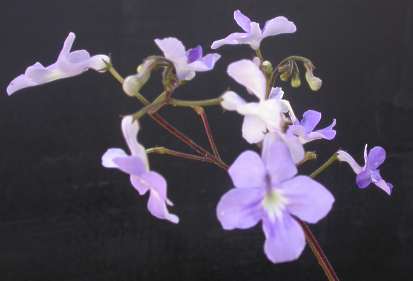
Description
Description
Streptocarpus polyanthus is a robust perennial herb in which each leaf is unifoliate, but is actually plurifoliate as a whole, which describes a situation where two or three phyllomorphs (individual plants with their own roots and flowering stems) grow from the base of the first unifoliate phyllomorph. One of the leaves stays dominant and larger than the others. While each leaf is monocarpic, meaning it will die after flowering and seeding, the plant as a whole will seem to be perennial and flower a number of times before dying, as each leaf takes a turn.
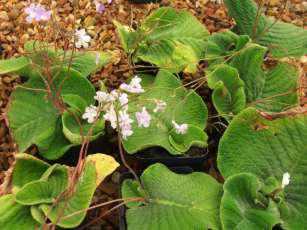
The leaves are almost succulent and are up to 240 mm long. The upper surface is greyish-green and the undersides are sometimes reddish-purple. No stems are present; each leaf is actually an individual plant with its own roots and flowering stems. Each leaf usually has a few flowering stems or peduncles of different ages, growing from the base of the midrib, so one leaf can simultaneously have an old stem with seed capsules, a stem with flowers, a stem with buds and some developing stems.
The flowering stems are about 150-200 mm long, with the tips drooping with the weight of the flowers; they often branch to form a few flowers on each stem.
The individual bilaterally symmetrical flowers are small but very pretty, pale mauve to violet with a white centre and a pale yellow throat. The flower typically has two lips, the upper is 2-lobed and the lower 3-lobed. The flower tube is cylindrical with a bulbous base and is bent in the middle. The flower has a notable characteristic of a strongly restricted mouth reduced to a narrow slit that is referred to as a 'key-hole'. Flowering time is spring and summer.
The fruit is a spirally twisted cylindrical capsule which feels velvety while it is developing; when ripe it is dry and the seed pod twists open in a spiral, releasing lots of very fine dark seeds.
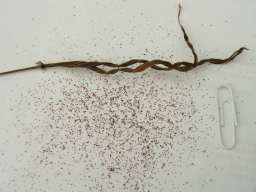
This plant is relatively fast growing as it takes one year for a young seedling to grow to flowering size.
Conservation Status
Status
Many of the Streptocarpus species are very specific in their distribution and occur in very small populations, making them vulnerable to any disturbance. Streptocarpus polyanthus does not have a rare, endangered or threatened status at the moment but S. kentaniensis, S. liliputana and S. formosus are threatened.
Distribution and habitat
Distribution description
Streptocarpus polyanthus occurs in the southern parts of KwaZulu-Natal on rocky outcrops and on forest margins, below 760m altitude, mostly in shade or dappled light, and in moist but very well-drained soils on soil banks, on sloping ground, in crevices or on rocks. It will not tolerate frost.
Derivation of name and historical aspects
History
The name Streptocarpus is derived from the Greek words streptos meaning twisted, and carpus meaning fruit, which is a perfect description of the plant's twisted seed pods. The species name polyanthus means many flowers.
In 1826, the collector James Bowie took the first plants of Streptocarpus rexii to Kew Botanical Gardens in England. S. polyanthus was also collected early on and taken back to Europe to be grown as a popular greenhouse plant.
There are a number of other subspecies of Streptocarpus polyanthus:
- subsp. comptonii which has small thick leaves, small white flowers.
- subsp. dracomontanus which has short flowering stems, few flowers.
- subsp. verecundus which has fewer and smaller flowers.
Streptocarpus belongs to the same family, Gesneriaceae, as the well-known African violets and gloxinias grown as pot plants all over the world. Gesneriaceae — named in 1969 after a Swiss scholar, Konrad Gesner, thirty years after his death — is a large family of mostly tropical and subtropical herbs, with ± 130 genera, and ± 2900 species worldwide. There are eight genera in Africa, one of which is Streptocarpus, native to southern Africa and which has ± 51 species.
Ecology
Ecology
Gesneriaceae are often epiphytic (growing on trees) or lithophytic (growing on rocks), The plants can be cross-pollinated easily with other species but in many instances are self-pollinated. The very small seeds are wind distributed.
Some other interesting facts about Streptocarpus: each leaf is phyllomorphic i.e. an individual plant with its own roots and flowering stems; some species are unifoliate and are monocarpic i.e. they flower and then die; the flower is zygomorphic i.e. bilaterally symmetrical, so it can be cut in only one plane to give two identical halves.
Uses
Use
Some species of Streptocarpus are used in Zulu medicine where leaf infusions are drunk to ease birth pains. Each flower stem lasts a few days when cut for the vase. Streptocarpus hybrids are very popular indoor pot plants, particularly overseas. It is interesting to note that only a few species were used as parent plants in order to develop the hybrids available today. With such great variation within species which easily hybridize, there is still much scope to develop completely new hybrids. There is much interest and a growing demand for Streptocarpus in South Africa.
Growing Streptocarpus polyanthus
Grow
Streptocarpus polyanthus is an easy-to-grow plant. It does best as a pot plant rather than planted out in the garden. Ensure a warm spot with good light but no direct sunlight. The plant in general is very sensitive to light, is burned easily by the sun, and flowers poorly in deep shade. Light shade with good ventilation is best for growing healthy plants with plenty of flowers.
Watering Streptocarpus should be done with care. It is very important that the plants should not be over-watered, to avoid rotting and fungal problems. Allow them to get quite dry between watering; they can be allowed to wilt slightly as they have the ability to recover very well from this — but be aware that severe wilting can be a sign of root rot caused by over-watering. So, check the medium to see that this is not the case. During the warm summers when they are actively growing, they need plenty of water. Most Streptocarpus species 'rest' during winter and this slight dormancy will cause them to need very little water during this stage.
Regularly remove all dead, unhealthy, dying leaves and flowers as these encourage fungal growth, and to keep the plants looking attractive. The tips of the leaves often die off as they get older and when stressed by drought or low temperature or when overwintering. This survival tactic does not harm the plants — although the dead ends may look unattractive, each of the leaves simply forms an abscission layer and continues with new growth from the base. Regular feeding during the growing season with liquid foliar feed is recommended.
All propagation is best done in spring which is the start of the growing season, Streptocarpus polyanthus can easily be grown from seed, and this is the recommended method of propagation — leaf cuttings will not meet with success as the leaf is monocarpic. When sowing the seeds, mix a pinch of the dust-like seeds with a small amount of sand to assist with spreading the seeds evenly. Use a well-drained medium that is not too coarse. Cover with a very thin layer of sand, keep out of direct sun but in a warm spot.
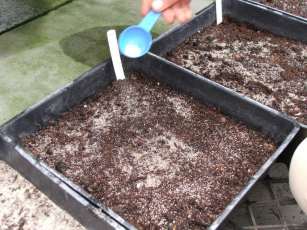
Germination usually takes 3-4 weeks. It is important not to allow the seedlings to dry out, so water regularly with a fine spray. Plant the seedlings into small pots only once they are quite big and strong. Transplant again into bigger pots when the roots have filled the small pots.
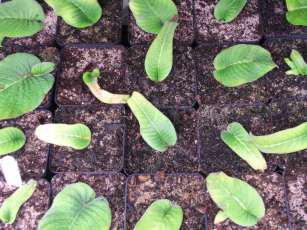
The potting medium we use at Kirstenbosch consists of the following: 1 part good compost : 1 part coarse sand : 1 part palm fibre. Add a small amount of organic fertilizer. Mature plants often lose their vigour after 3-5 years and should be replaced with younger plants.Worms are the most troublesome pests of Streptocarpus. They can either be hand collected or sprayed with a suitable poison. Fungal infections are also a cause for concern; if fungus is found on any part of the plant, remove the affected parts and treat with a suitable fungicide.
References
- Burtt, B.L. & Hilliard, O.M.. 1971. Streptocarpus, an African plant study. University of Natal Press, Pietermaritzburg.
- Hutchings, A. 1996. Zulu medicinal plants. An inventory. University of Natal Press, Pietermaritzburg.
- Leistner, O.A. (ed.). 2000. Seeds plants of southern Africa : families and genera. Strelitzia 10. National Botanical Institute, Pretoria.
- Pooley, E. 1998. A field guide to wild flowers of Kwa-Zulu Natal and the Eastern Region. Natal Flora Publications trust, Durban.
Credits
Cherise Viljoen
Kirstenbosch NBG
December 2007
Plant Attributes:
Plant Type: Bi/Annual, Perennial
SA Distribution: KwaZulu-Natal
Soil type: Loam
Flowering season: Spring, Early Summer, Late Summer
PH: Neutral
Flower colour: Mauve/Lilac
Aspect: Shade
Gardening skill: Average
Special Features:
Horticultural zones







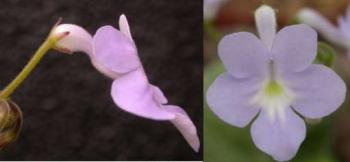
Rate this article
Article well written and informative
Rate this plant
Is this an interesting plant?
Login to add your Comment
Back to topNot registered yet? Click here to register.